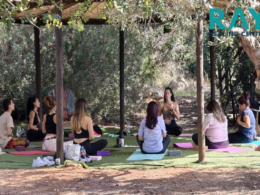Across the West, trends are dispersed, washed away and replaced by new ones, and this tiny island at the heart of the Mediterranean Sea acts as their spectator. Trends are embodied by the island’s inhabitants and are primarily disseminated and consumed through brick-and-mortar retail stores. Typically, these stores select a selection of the season’s most popular cuts or patterns, often overlooking niche microtrends.
Whilst trends are being wrung dry, venturing too far from the conventional uniform can elicit awkward stares from passers-by. As this cycle continues, an unspoken norm develops. Boundaries form around what is considered acceptable attire and a tension between individuality and conformity can develop into an angst against conservative norms.
Throughout Maltese art and fashion history, the island’s aesthetic has been sculpted by nearby Italian regions, particularly Baroque imagery, still prevalent in popular culture and tradition. The vibrant colours and intricate patterns of various Maltese designers reflect the island’s rich heritage, enriched further by the influence of natural sunlight and the warm climate. Maltese women often gravitate towards bolder pieces for occasion or evening wear, typically earrings, necklaces, scarves or flashy logos.

However, our unspoken cultural norm discourages straying too far from conformity. This societal pressure can stifle creativity and individuality, particularly among the youth. They feel compelled to adhere to traditional clothing and worse yet, blindly follow trends set by influencers and fuelled by fast fashion outlets.
When teens hear the phrase ‘hekk hierga?’ from unamused parents they are pressured to conform to ‘appropriate’ Maltese style. This pressure on Maltese girls and women is so prominent that we are caught between staying on trend and modern-day decorum.
My question is, would Maltese teens be more open to developing a unique style – though still influenced by celebrity culture and online trends – if faced with a less judgemental audience? If youths separated themselves from the ‘hive mentality’ of societal clothing norms, would this encourage genuine self-expression and individual thought?
The simple answer is yes, but even in the most fashionable districts, many tend to favour functional and often understated clothing. In contrast, those who dare to wear unique or interesting pieces—especially those embracing Maximalism— stand out noticeably. What strikes me is the perceived audience in these environments; the presence of a more accepting atmosphere seems to allow for greater experimentation without fear of judgment.
A less judgmental audience can be pivotal in fostering a culture of creativity and self-expression. In environments where individuality is celebrated rather than scrutinized, people may feel more empowered to explore and embrace unique fashion identities. The interplay between community, context, and personal style suggests that a supportive environment can encourage greater stylistic experimentation and innovation. Still, personal style comes down to the individual.

Reflecting on past generations, it’s evident that teenagers and youths once adopted a more minimalist approach in their wardrobe, often acquiring only a limited number of items each season. My grandmother, for instance, fondly reminisces about visiting village markets to purchase fabric, from which her mother would produce tailor-made dresses. They often selected patterns from the German magazine Burda, showcasing a blend of creativity and craftsmanship. In addition to custom-made garments, she recalls the thrill of buying off-the-rack clothing from local retailers like Big Ben Group, and the excitement of Marks & Spencer’s arrival when they opened their first outlet in the 1960s. The fashion landscape evolved significantly during the 1970s and 1980s, with an influx of franchises offering diverse styles and options. This evolution has continued into the present day, leading to a vastly different shopping culture where rapid consumption and the influence of global trends dominate the market.
In the 80s and 90s, trend cycles used to be much longer, and with the rise of a more commercialized aesthetic, teenagers often gravitated towards purchasing more T-shirts and jeans, as promoted in style magazines. Visiting village markets on Sunday mornings was a beloved pastime, allowing families to explore local crafts and hand-picked products. Today, Maltese teens primarily shop from fast fashion retailers, or attempt to follow the Western trend of curated thrift stores. Currently, we are generally limited to four main brick-and-mortar retail outlets scattered across the island. This shift not only reflects changing consumer behaviours but also highlights a reliance on fast fashion that prioritizes rapid turnover over individuality and craftsmanship.
The recent rise of thrifting in Western culture has found some resonance on the island, with teens and young adults seeking out second-hand clothing through curated thrift stores. However, the variety and quality of second-hand stores in Malta differ significantly from those found in metropolitan European cities or American states. More often than not, second-hand pieces are low-quality and upcharged. Maltese youths typically have access to only a handful of vintage shops that sometimes curate items to fit mainstream notions of what vintage should look like. Perhaps a broader range would allow for more unique self-expression.

While there are a few charity shops on the island, they have not gained the same popularity as curated vintage stores. Additionally, the local village markets often feature a selection of low-quality knock-offs, catering to the contemporary Maltese culture’s widespread affinity for branded labels. This reliance on limited retail options can stifle the development of more unique personal styles among young Maltese, as they may feel pressured to conform to mainstream aesthetics. Aside from concerns for individuality, fast fashion fuels carbon emissions that worsen Malta’s already rising temperatures and surely doesn’t help the rising sea levels which threaten the islands’ coastlines.
The sight of semi-clad tourists during the summer months can create a sharp contrast for Maltese youths, who might feel torn between local modesty norms and the perceived freedom tourists have to dress more casually or revealingly. This could push for more relaxed dress codes or, alternatively, some judgemental eyes may reinforce adherence to more conservative local style. Also, the influence of social media influencers cannot be denied. Absentminded adherence to mainstream trends may lead local youths to embrace carefree, beach-style fashion, conflicting with Malta’s more modest dress culture.

Maltese women and girls often find their style heavily influenced by their mothers’ tastes. I attribute a significant part of my style development to my mother, whose experimentation with bold colours and silhouettes has inspired me to break free from cultural uniformity. Her approach to fashion encourages me to embrace individuality and express myself more freely, challenging the norms that often dictate what is deemed acceptable or fashionable in our society.
The series of articles is centred around themes of art, fashion and national identity in post-colonial regions. See the full article, including additional images and Rebecca’s sources.
This set of photos showcases the bold soul of Maltese identity and scenery.










